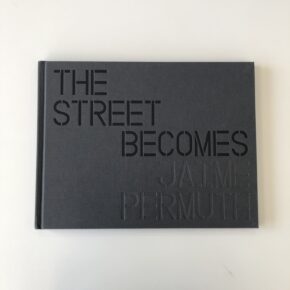It wasn’t until this morning, a few minutes ago, that I noticed the connection. As you might imagine, I take a big stack of books from photo-eye each time I visit, and make my selections later on, at home. Sifting, I noticed the link. Two books, sharing half a name. “Half Life,” By Michael Ackerman, and “The Half-Life of History, by Mark Klett. Strange.
Given the constraints of a book review column, it seemed like a connection worth investigating. Perhaps my curiosity was aroused, as a 37 year old, having lived half a life. Perhaps not. Perhaps I was thinking about how the Buddhists believe everything is connected. Perhaps not.
“Half Life” was recently published by Dewi Lewis in London. I don’t read the essays beforehand, in these books, just like I don’t bother with wall text, right away, when I go see an exhibition. It’s easy to double back, but one only gets a single chance to see the images fresh, without pre-conceptions. It’s not a perfect system, but it allows me to read and react, to guess at symbols, patterns, and deeper meaning.
I’d never heard of Mr. Ackerman before, but it was immediately obvious that his intentions were serious. The initial images are small, grainy, black and white, and have the look of old, found images. Head shots of forlorn, wasted looking men, this was not to be a fun ride through photo-book-land. Soon, train-tracks, blurry, snowy fields, European architecture. I thought of the Holocaust, as most people would. Then, images of naked people would appear, and hotel rooms. I thought of the sex trade. Next, Hebrew-covered headstones, and I was back to the Holocaust all over again.
I guessed the images to be current, and a subsequent cursory glance at the photographer’s bio said as much. So the images are not historical, they just reference that impossible era. Showers, even. But the nudes returned, and the power of the random single image resonated as well: a tranny penis, an elephant, an egret? I liked the embedded photo-homage as well: a sign saying Franks on one page, a big American flag on the opposite spread. Together, it’s a winding narrative with many references, but the end result is unique.
I’ve always thought it was easy to make creepy work. Either way, this book is definitely meant to disturb. It speaks of ghosts and visions, memories of the dead and the lost. Yet it has an undeniable beauty to it, like Anne Frank’s Diary. Why do people continue to read that book, when the ending is foretold? Because they enjoy the ride, I suppose.
Bottom Line: Haunted, in the best possible way
To purchase Half Life visit Photo-Eye.
The partner publication, in name only, “The Half-Life of History,” is more straight-forward, and in large part, color. Which surprised me, as all of the past work I’ve seen from Mr. Klett has been some shade of gray or sepia. Beautiful Saguaros that finally made sense the last time I set foot in Tucson. The new book, offered by Radius, is subtitled “The Atomic Bomb and Wendover Air Base,” whence the Enola Gay originated. Boom. Back to World War II, again, like it or not.
The style varies, from tightly-composed images of abandoned barracks, to sweeping vistas, and a four-page spread inside a airplane hanger. 50 caliber bullets are handled sculpturally, history is depicted gingerly, and a short trip to Hiroshima is made towards the end. The essay is by William L. Fox, a very bright scholar whom I heard lecture in Reno recently. I haven’t read it yet, but will speculate that he did a good job. (Lazy journalism, right there. For sure.)
Bottom Line: Interesting, a must for Klett collectors















5 Comments
Jonathan,
These are perfect for the holiday season!! I’m not sure which holiday, and I would probably want to be sober when looking at these….
I have Ackerman’s first book “End Time City” and it is shot in the same style. I had to own it, because the images are amazing and also I am amazed that a publisher would produce it and I feel that I have to support that kind of “honesty”. But I rarely look at it because it is disturbing. Am I making any sense?
Yes, you’re making sense. No question about it.
[…] the original post: This Week In Photography Books « Newt Gingrich Sells Books And Films While Campaigning For … Shakespeare's […]
I am not sure what drew me into history, in think in part due to my mother, she was a child during WWII in Berlin and eventually a relatives place in the country, yet I digress. The thing is when I was growing up, a TV series called the world at war ran for a while, some of the scenes were really not suitable for a young kid but it had and impact, from what I see here, both books represent the same brutal truth show in the TV series. Nice call JB.
What do you mean that it’s easy to make creepy work? What makes it easy?
Comments are closed for this article!